|
SpaceTides
e-zine
#41 - 13 April 2006
Internet
Newsletter of ASSA Bloemfontein Centre,
South Africa, to the public
www.assabfn.co.za/spacetides
|
In this issue of SpaceTides
|
INDEX
1. Spaceflight news from
around the world
2. Astronomy news from around the world
3. Interesting space facts
4. Space Questions
5. Sky Observation log
6. Amateur Astronomers' Corner
7. Astronomy & Science in Africa
8. Astronomy events in the City of Bloemfontein
9. Photo Sense
10. Web links and Software
11. Advertisements (Astronomy Beginner's Day in Bloemfontein
- 22 April 2006)
|
Dear
SpaceTides subscribers
I had
an interesting question recently regarding the value of astronomy
and spaceflight to society. Why do we spend billions and billions
on astronomical research and the building of spacecraft for planetary
exploration? Shouldn't we rather use that money for immediate problems
facing communities? Some people oppose such modern and sophisticated
endeavours and ask whether it has any impact on our daily lives.
Well, I can think of numerous reasons why we should INCREASE spending
on astronomy and spaceflight! In the coming weeks I'll send out
a special report on why astronomy and spaceflight should be encouraged
and why it does have an effect on the average man on the street.
Please
see the advert in section 11. On Saturday 22 April
2006, ASSA Bloemfontein will be hosting a beginner's day in practical
astronomy.
I added a new section to the e-zine called "Photo Sense"
- a specially selected picture for each issue. If you have a photo
you took that you think can appear in SpaceTides, please send it
in!
Gerrit Penning
Editor
Total subscribers as at 13 April 2006: 447 (+20 from
previous issue #40)
|
|
1. Spaceflight news from around the world
|
|
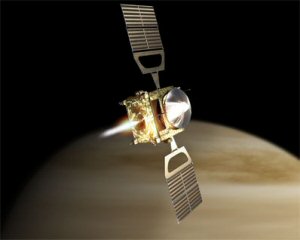
|
Venus
atmosphere the target of ESA space probe
The
planet Venus has welcomed a visitor to its orbit on 11 April 2006,
in the form of the European Space Agency's "Venus Express"
satellite. It is now the only active, operational satellite orbiting
Venus.
The planet's surface was mapped by the very successful Magellan
spacecraft in the 1990's. From previous research, scientists discovered
that Venus is enshrouded in a thick atmosphere. Due to extreme temperatures
and pressure created by the atmosphere, a greenhouse effect of tremendous
proportions is generated.
Venus Express is tasked with a detailed study of the atmosphere,
using sophisticated sensors to solve the mysteries of the past.
"It will also be the first Venus orbiter to conduct optical
observations of the surface through 'visibility windows' discovered
in the infrared spectrum".
ESA article: http://www.esa.int/esaCP/SEM2GQNFGLE_index_0.html
Image at left:
artist impression of the Venus Express. Credit: ESA.
|
________________________________________________________________________________________
|
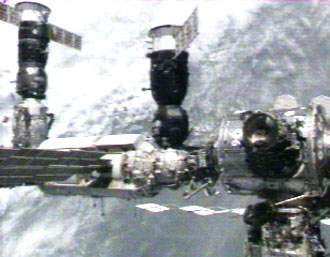
|
Expedition
13 the new crew on the ISS - April 2006
The
Soyuz spacecraft carrying the 13th International Space Station (ISS)
crew, Commander Pavel Vinogradov and NASA Science Officer Jeffrey
Williams, arrived at the ISS on Friday, 31 March 2006.
With them was Marcos Pontes, the first Brazilian astronaut to go
into space. He spent 8 days on board the station before returning
to Earth with the Expedition 12 crew on 8 April.
More at: http://www.nasa.gov/mission_pages/station/main/index.html
Image at right: The Russian Soyuz
spacecraft can be seen in the centre, carrying Expedition 13 just
moments after docking to the space station.
Credit: NASA TV
|
|
2. Astronomy news from around the world
|
|
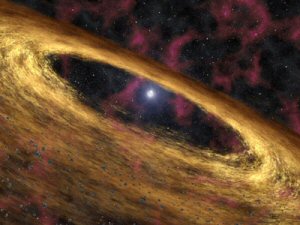
|
Debris
field found around pulsar - released April 2006
NASA's
Spitzer Space Telescope found evidence that a potential planet-forming
disk exists around a pulsar. Pulsars are a class of supernova remnants,
called neutron stars, which are incredibly dense. A neutron star
can form when a massive star heavier than 1.4 times that of the
Sun explodes. They consist of atomic matter (neutrons) squeezed
into bodies only 10 to 20 km wide. A teaspoon full of neutron star
matter can weigh more than 2 billion tons!
The pulsar observed by Spitzer's infra-red sensors was one such
massive star that exploded, throwing off huge amounts of matter
into space. A disk formed around the neutron star and the debris
in this disk might ultimately stick together to form new planets.
Radiation from the pulsar however, would be so intense that the
poor planets will probably be some of the most inhospitable planets
in the Universe.
Left: artist impression of debris disk around a pulsar. Credit:
NASA/JPL
http://www.spitzer.caltech.edu/Media/releases/ssc2006-10/release.shtml
|
For
daily astronomy and spaceflight news to your inbox, SpaceTides
recommends that you subscribe to
the free service offered by Universe Today: www.universetoday.com.
|
3. Interesting Space Facts
|
|
Naming of the stars: only the International Astronomical
Union (IAU) may attach names to stars and other solar or deep sky
bodies. Any name that you attach to a star either personally
or commercially will not be recognized by the scientific community
at all. If a business offers you star naming services, there won't
be any legal "copyright" on the name. More at http://www.iau.org/BUYING_STAR_NAMES.244.0.html
The lowest temperature that can be theoretically attained
(where the kinetic energy of atoms and molecules becomes minimal)
is referred to as "Absolute Zero". It equals zero Kelvin
or -273.15 degrees Celcius (-459.67 Fahrenheit). Although absolute
zero is not achievable in practice, you may find areas in outer
space approaching this limit. http://en.wikipedia.org/wiki/Absolute_zero
A Bushman myth explains the monthly phases of the Moon:
the Moon was once a man who incurred the anger of the Sun. The Sun
then attacked the Moon with his bright shine, slowly cutting up
the Moon until only a small sliver remained. The Moon begged the
Sun to at least spare this small piece for his children. The Sun
agreed, but the Moon began to grow again. Once back to its original
size, the process repeated itself. From the 2006 Sky Guide Africa
South, page 57.
|
|
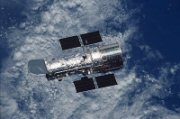
|
Can
the Hubble Space Telescope take pictures of the Earth?
No. Hubble is travelling at a tremendous speed as it orbits the
Earth (about 27 000 km/h). It orbits at an altitude of about 600
km. Hubble's pointing system is designed to target and track objects
in the distance, much further away from Earth. It won't be able
to track an object on the Earth, as the object will make streaks
on the picture. The picture at left shows the Hubble above Earth,
while in orbit. (credit: NASA)
From: http://hubblesite.org/reference_desk/faq/answer.php.cat=topten&id=78
|
___________________________________________________________________________________________
|
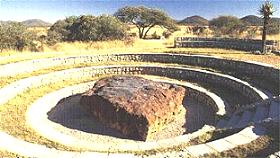
The Hoba meteorite near Grootfontein in Namibia - the world's largest
known meteorite. Image obtained from www.namibweb.com/hoba.htm.
Information at right from: http://epswww.unm.edu/iom/howto.htm
|
How
do I tell the difference between a meteorite and an ordinary Earth
rock?
If
you are not an expert, it will be difficult to ascertain whether
a rock you picked up is a meteorite from space. Here are a few characteristics
of space rocks to keep in mind though:
- Metal: most meteors contain some iron metal, shining visible on
a broken surface
- Density: Many meteorites are extremely dense and weigh more than
similarly-sized rocks found on Earth
- Magnetism: meteorites tend to easily attract a magnet due to metal
content
- Chondrules: most meteorites contain small balls of stony material
called chondrules about a millimeter across.
- Fusion crust: because the meteor burns as it falls through the
atmosphere, a thin layer on the surface melts, creating a black
or brown colouring.
- Regmaglypts: it may happen that thumb-print patterns (regmaglypts)
develop on the surface of the meteor as it falls through the atmosphere.
Remember that in South Africa, any meteorite falling within the
country's boundaries belongs to the government, immediately. Private
possession of or trade in meteorites is illegal - it should be handed
over to your nearest science institute, University or the authorities!
|
__________________________________________________________________________________________
On
the lighter side...
|
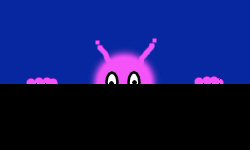
|
What
can I do to prevent myself from being abducted by angry-looking
pink aliens resembling my favourite Hollywood actor? I'm having
problems sleeping at night. And I'm hearing funny noises in the
roof.
Though
it might not prevent it, consider taking out UFO abduction insurance!
If you do get abducted and something less-than-favourable happens
to you, you might just get compensated for the damage. Just type
"alien abduction insurance" into Google and go to any
insurer of your choice... Also, check the inside of your roof. It
might be rats or even unemployed circus clowns frolicking around.
It's a growing concern.
|
|
Descriptions for mid April 2006 around 20h00 from
South Africa .
Planets visible
Mercury is in the constellation of the Fish (Pisces), being
a morning object visible just before sunrise. It moves into
Cetus from the 21st of April.
Venus shines bright in the morning hours before sunrise
and is located in Aquarius.
Earth is currently orbiting an average yellow coloured star
not far from Alpha Centauri. The planet will clearly appear blue
and white if you come within a few hundred thousand kilometers.
Just beware the space debris orbiting around it please.
Mars is an evening object and has moved into Gemini
in the north-west. It is visible with its typical reddish shine.
Binocular users: watch as Mars approach the open cluster M35 in
Gemini...
Jupiter is an evening object in the east. It rises
earlier each evening (currently around 19h00), still located in
Libra. A pleasure to look at through a telescope.
Saturn is still lying close to the Beehive open cluster (M44)
in the north, in the constellation of Cancer (the Crab) in the evenings.
Constellations
and stars
For those who still need to do observations in the summer constellations
of Gemini, Canis Major and Orion - catch them while their still
visible as they're busy setting...
The galaxy-rich constellation of Leo is your telescope's
perfect target for an evening of galaxy hunting. If you're not accustomed
to galaxy observations, start out with the Messier objects first.
Virgo, also a treasure-trove of galaxies are busy rising
and is becoming well-placed for observations.
Catch up on your autumn constellation knowledge while the temperature
is still acceptable. Corvus the Crow and Crater the
Cup are easy targets for beginners. If you're up to a challenge,
try seeing Hydra, the Sea Serpent, in full view!
It's the best time of the year for southern sky observations, with
the constellations of Puppis, Vela and Carina as
well as Crux and Centaurus perfectly situated for
deep sky observations. Make use of the opportunity!
Other
events
Full moon on 13 April 2006. New moon on 27 April 2006.
|
|
6. Amateur Astronomers' Corner
|
|
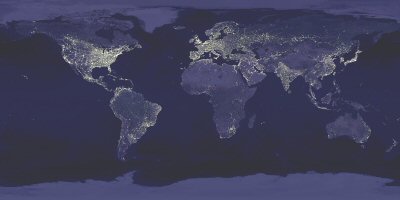
A computer rendered
image showing the major light sources on Earth. South Africa's major
hubs are evident on the image. Visit the
International Dark-Sky Association's website: www.darksky.org - proper light fixtures,
PowerPoint presentations, outdoor regulations and more.
|
Light
Pollution - the amateur's role
Although it is
everybody's responsibility, the amateur astronomer can play an important
role in reducing light pollution through public awareness.
If you belong to an astronomy club, attempt building such awareness
into your public presentations and materials. You can even host
evenings around the concept of dark skies, in very creative ways.
Switch on all the outdoor lights and show visitors the effect when
switching them off. See how they understand! A special emergency
session after it was noted that the Milky Way has disappeared can
also have an impact...
If you are associated with an observatory, invite people living
nearby for a free evening at the observatory. Register with
a dark sky association.
|
|
7. Astronomy & Science in Africa
|
|

Website of the
WGSSA:
http://www.saao.ac.za/~wgssa/index.php
|
The
Working Group on Space Sciences in Africa
From the WGSSA website:
"The
Working Group seeks to promote the development of the space sciences
in Africa by initiating and coordinating various capacity-building
programmes throughout the region. These programmes fall into a broad
spectrum ranging from the promotion of basic scientific literacy
in the space sciences to the support of international research projects".
|
For
other SA Astronomy websites, go to the SpaceTides SA Astronomy
Portal at:
www.assabfn.co.za/spacetides/sa_astronomy.htm
|
8. Astronomy Events in the City of Bloemfontein
|
The
different astronomy organisations in the City, working hand-in-hand
to inform people about the
interesting world of astronomy and spaceflight,
can be reached through the following details:
|
Explore Boyden Observatory:
www.assabfn.co.za/friendsofboyden/explore.htm
One of the most publicly accessible
observatories of its kind on the continent, also housing SA's third
largest telescope. To arrange group visits to the Observatory,
phone Dawie van Jaarsveldt at +27 +51 - 401 2561.
|
|
The Friends of Boyden: www.assabfn.co.za/friendsofboyden
A
public interest group for Boyden Observatory and for people interested
in joining the astronomical community of Bloemfontein,
but not necessarily make astronomy their hobby. Contact Braam van
Zyl at 051-436 7555 (h) or visit the website above for more information
regarding the Friends. Anyone can become a member. R50 membership
fee per year for a whole family. Members receive the latest information
on astronomy events in Bloem, attend the Friends' presentations
free of charge and receive the "Naghemel" quarterly newsletter
compiled by ASSA Bloemfontein, by post. Please phone Braam for information
on next meeting.
|
|
ASSA
Bloemfontein
Centre: www.assabfn.co.za
Affiliated
with the Astronomical Society of Southern Africa, the Bloemfontein
Centre of ASSA is an active organisation of amateur astronomers
meeting on a regular basis to discuss and practice astronomy as
hobby. Activities include solar-, lunar-, deep sky- and comet &
meteor observations, as well as historical research, telescope building,
tours and away-weekends under dark skies. Send an e-mail to mail@assabfn.co.za
or visit the website.
22 April 2006: Beginner day in practical amateur astronomy,
concentrating on night sky observations. See section
11 for more information.
|
Onthou ook om Boyden Sterrewag se gereelde sterrekunde
berigte in die "Ons Stad" plaaslike koerant te lees.
Dit bevat ook meer inligting rondom Boyden besoektye.
|
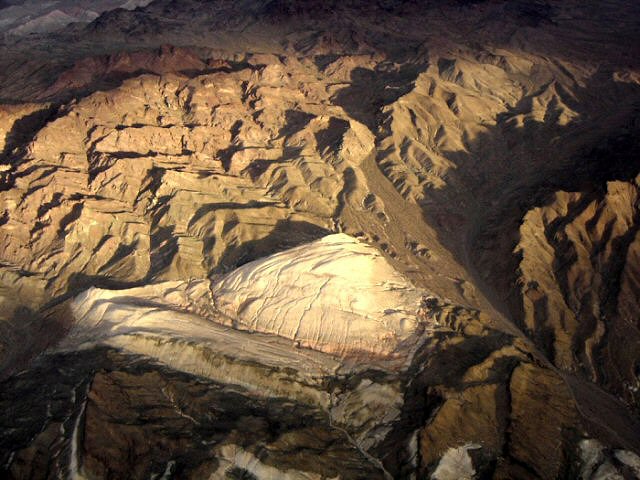 Image
of an area on the outer edges of the Grand Canyon in the
USA, approaching Las Vegas. The photo was taken from the air.
F/5.6, 8mm focus length, 1/125 sec exposure. Upward contrast adjustment
to enhance colours. Photo taken 31 December 2005 by G. Penning. Image
of an area on the outer edges of the Grand Canyon in the
USA, approaching Las Vegas. The photo was taken from the air.
F/5.6, 8mm focus length, 1/125 sec exposure. Upward contrast adjustment
to enhance colours. Photo taken 31 December 2005 by G. Penning.
|
|
10. Web links and Software
|
|
11. Advertensie - Sterrekunde Beginnersdag:
22 April 2006
|
|
Beginnersdag
in praktiese amateur sterrekunde - 22 April 2006
(Inquire
if you would like the course to be partly in English).
Datum: Saterdag, 22 April 2006
Plek: Boyden Sterrewag, 25 km buite Bloemfontein na ooste, by
Maselspoort vakansie-oord
Tyd: 14h00 vir 14h30 tot 22h00
Koste: R40 per persoon. Sluit in basiese sterkaarte en planisfeer.
Bring saam: Verkyker as jy het, ligte aandete, klein flitse,
warm klere.
Bespreking: Bespreking is noodsaaklik. Kontak Gerrit
Penning by mail@assabfn.co.za
of skakel 084 429 9080.
"Waar en hoe begin ek met sterrekunde?"
Hierdie mini-kursus aangebied deur ASSA Bloemfontein sal 'n paar
basiese aspekte van naglugwaarnemings aanspreek (uitken van konstellasies,
sterre, planete). Daar word ook gekyk na hoe 'n mens 'n sterkaart
en planisfeer effektief gebruik, die koordinaatstelsel, dieplugvoorwerpe
vir die oog, verkyker en teleskoop en ook hoe om 'n verkyker aan
te wend vir sterrekunde. 'n Paar multi-media aanbiedinge oor algemene
sterrekunde sal sorg vir verskeidenheid. Ander onderwerpe waaraan
geraak word sluit in komete en meteore, teleskope en sterrewagte,
die maan, son en andere.
Kom geniet 'n rustige dag by Boyden en verbreed jou naglug kennis.
Enige iemand welkom, al weet jy nie veel van sterrekunde nie.
 Krediet:
Stellarium
Krediet:
Stellarium
|
SpaceTides is a free internet e-zine for persons interested in expanding their
general knowledge of astronomy and spaceflight.
The e-zine originates from the City of Bloemfontein in South Africa and
is compiled us a service to the public by ASSA Bloemfontein Centre
as part of their educational outreach activities. Website: www.assabfn.co.za.
SpaceTides contains links to various other third party sites on the
internet, not always connected to SpaceTides. The persons and entities
responsible
for compiling SpaceTides will not be held responsible for the content
or information on these third party sites or any damage of any kind
incurred from
downloading, opening, or viewing anything from/through these sites.
If you would like to unsubscribe from SpaceTides, send an e-mail
to spacetides@assabfn.co.za with the word
"Unsubscribe" in the subject line.
|



